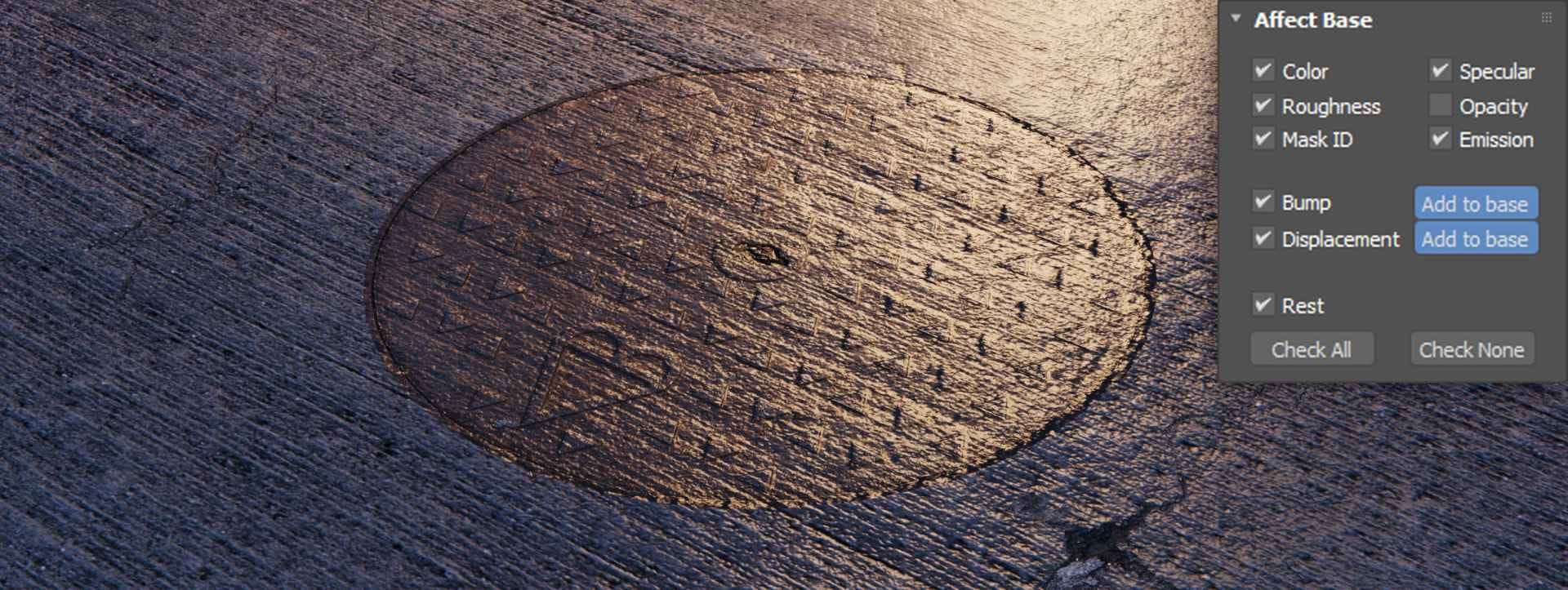Corona Decals act like stickers, projecting materials onto your geometry for extra detail. This article explores various traditional and unconventional ways to use Decals.
Corona Decals are special box-shaped objects which you can use to project materials onto your geometry. You can think of them as little stickers covering your scene with extra detail wherever they are placed. They don’t necessarily need to be little though, and thanks to their advanced options you can achieve much more than just adding details. In this article we’ll explore various traditional and unconventional ways of using Decals.
Getting Started
You can create a Corona Decal by clicking on the Decal icon in the Corona Toolbar and drawing a Decal in the viewport:

Note for Cinema 4D users: we are using 3ds Max here, but Corona Decals are available in both 3ds Max and Cinema 4D and offer the same features.
Pro tip: hold Ctrl while creating a decal to make it square-shaped:

Once you add a decal to your scene, apply a material to it and move it so that it overlaps with your scene geometry:

As a result, the decal’s material is projected onto your geometry:

It’s really that simple, but Decals offer many advanced options and you can use them to achieve more effects than simply projecting materials. More on that below.
No Detail is Too Small
Let’s start with some basic examples. One typical use of Decals is adding small details to your scene to make it appear more authentic – for example, you can spray your walls with graffiti or stick posters on the streets:

In the above example, a decal with a graffiti material is applied to the concrete wall below the bridge. We used a CC0-licensed graffiti texture here, which you can easily find online.
Another idea is adding stickers to your objects:

Note: Chaos condemns vandalism! 😉
Next thing Decals can help you with is adding weathering and damage to your scenes so that materials appear imperfect and lifelike:

The vertical crack on the concrete wall to the left is a Corona Decal available in Chaos Cosmos.
You can also use decals to add dirt to your vehicles to get that offroad feeling:

Decals can also have very practical purposes. For example, they can be used as street markings or direction signs:

Street marking Decals from Chaos Cosmos.
Lastly, decals can be very helpful in product design, for example if you need to apply a specific logo or a label to a product:

Now that we have a basic understanding of what decals are and how to use them, let’s explore some unconventional scenarios and learn a few tips and tricks.
Affect Specific Material Channels
One section you may have noticed in the Corona Decal options is “Affect Base”. You can use it to specify which material properties of the object onto which you are projecting your decal should be affected by that decal. This seemingly simple option provides you with a wide range of applications.
A glass with an embossed graphic:

Only “Displacement” is enabled under “Affect Base”. Otherwise, we would be also affecting other channels such as diffuse color or reflectivity. By the way, the ripples on the water surface are also achieved with a decal using a procedural gradient map. 🙂
Depending on your use case, you may need to use different “Affect Base” settings:

Bump off – the bump texture of the manhole cover is not used at all.

Bump on, Add to base off – the bump texture of the manhole cover fully replaces the underlying material’s bump texture.

Bump on, Add to base on – the bump texture of the manhole cover is mixed with the underlying material’s bump texture.
Tips and Tricks
Combine Decals with Other Features
Remember that you can use decals in combination with other Corona features. In this example, the leaves are decals distributed over the water surface using Chaos Scatter:

Additionally, we can use the Corona Multimap in “Decal” randomization mode to randomize the colors of the leaves:


You can randomize decal positions and rotation in a similar fashion using the Corona Mapping Randomizer.
Stack Decals
You can stack multiple decals on top of each other. The order in which they are applied depends on their position in the 3D space:

Use Procedurals
Remember that you are not limited to bitmaps. Decals support procedural textures as well!

Cover Curved Surfaces
Corona 12, currently available in experimental daily builds, offers a new decal bending option. This gives you better control over projecting decals on cylindrical surfaces such as bottles or glasses, or even on spheres thanks to bending in two axes!


You can download Corona 12 daily builds here:
Use Autogrid
Use the 3ds Max autogrid option when adding decals – this greatly simplifies the workflow:

Browse Chaos Cosmos
When searching for your perfect decal texture, check out the ones available in Chaos Cosmos:

Explore on your own
Remember that Corona Decals provide a non-destructive way to add details, allowing you to easily adjust and modify them without affecting your base materials. This means you can experiment freely, knowing you can always revert to the original state or make further tweaks without affecting your underlying work. As you continue exploring Corona’s capabilities, keep Decals in mind as a valuable tool for adding finishing touches and bringing your rendered visions to life.






